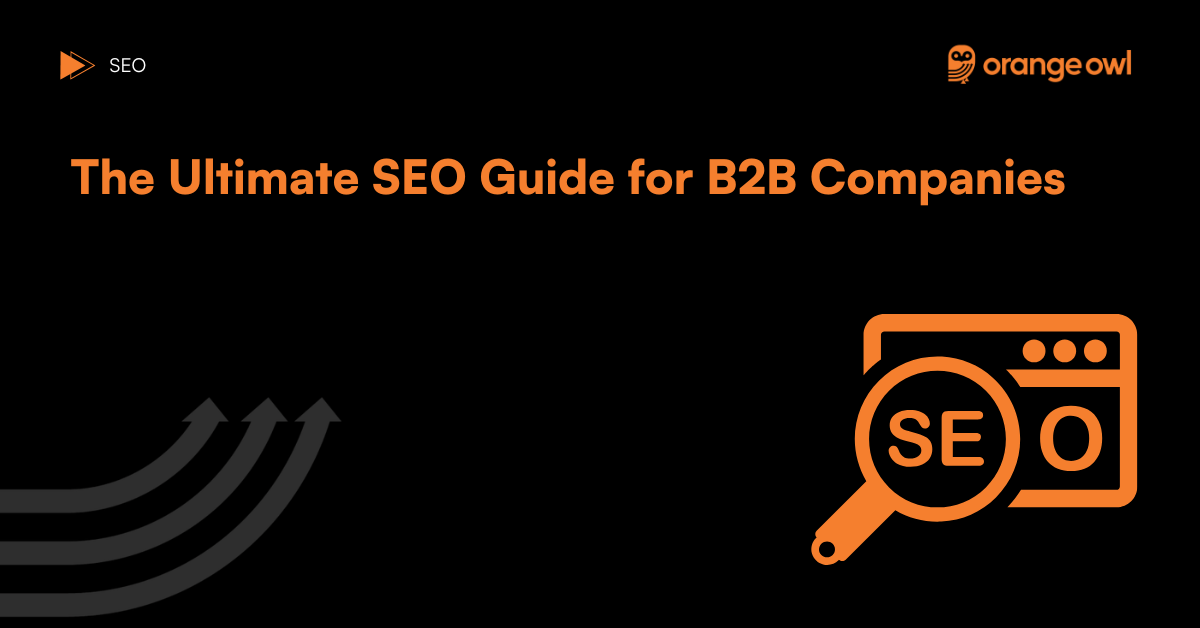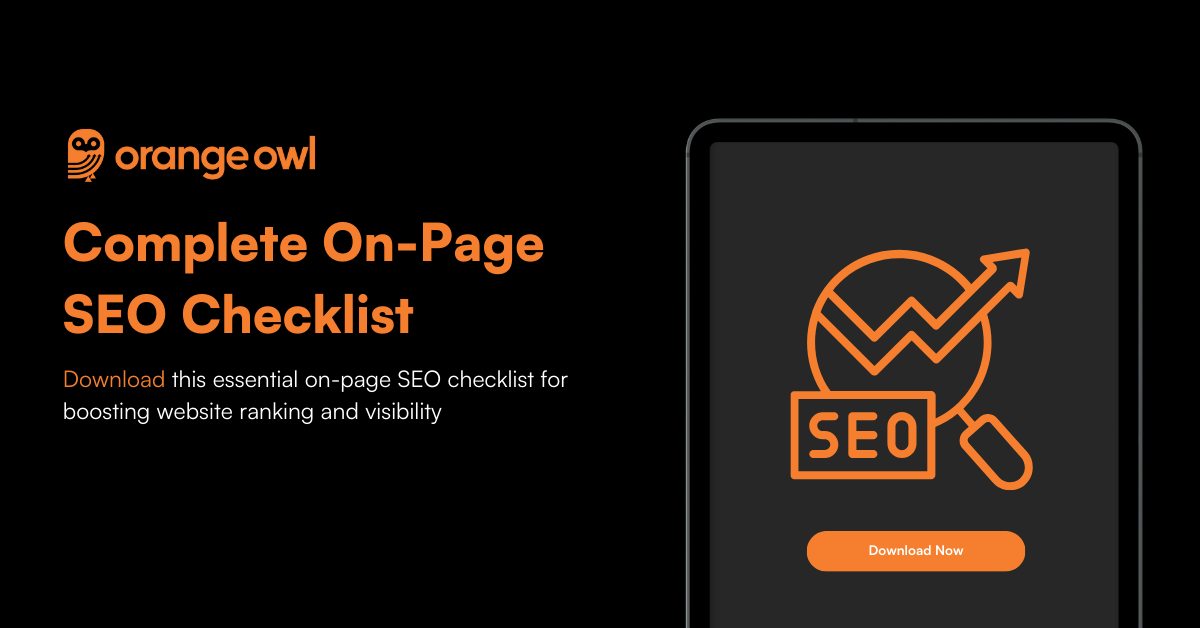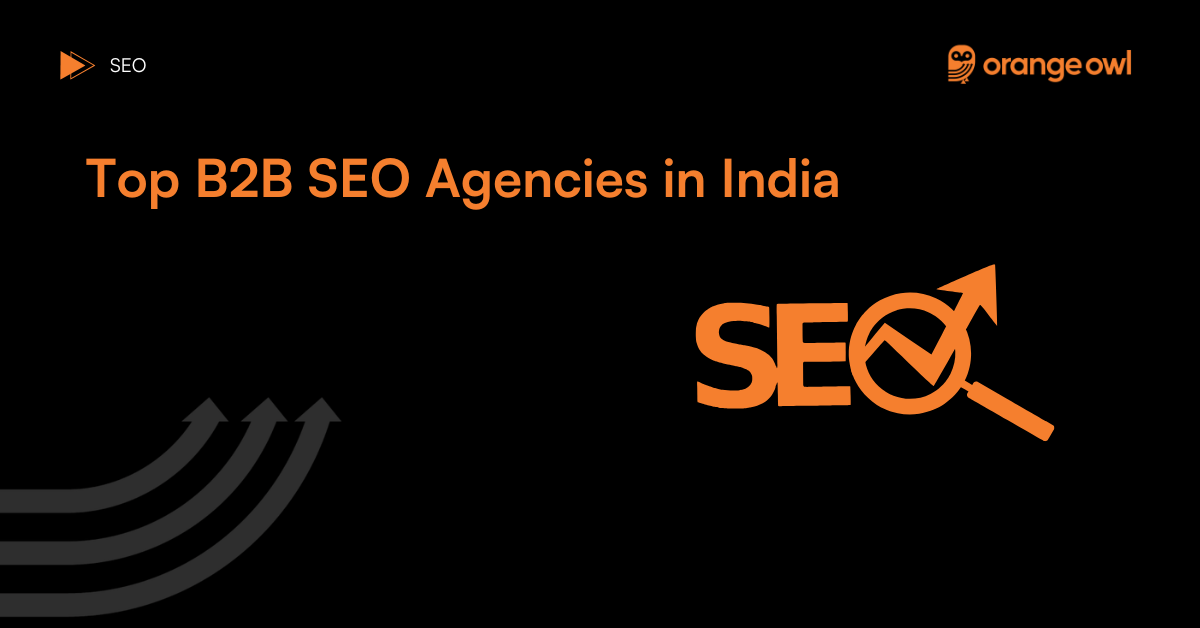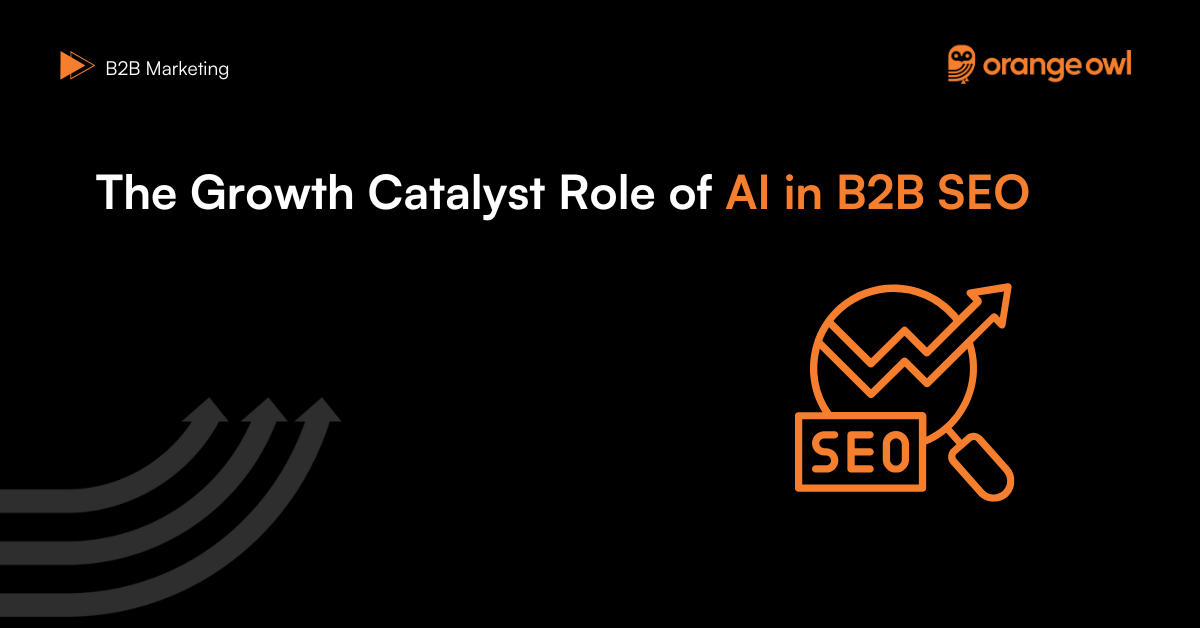The Ultimate SEO Guide for B2B Companies for 2025
Vivek Goel
February 8, 2025

Table of Contents
The Ultimate Guide to SEO for B2B Companies for 2025
Search Engine Optimization (SEO) is an essential go-to-market strategy for B2B companies looking to increase their online visibility, drive more qualified traffic to their websites, and generate leads. This comprehensive guide will delve into the intricacies of SEO for B2B companies, detailing the differences and strategies for on-page and off-page SEO, comparing their various aspects, and exploring the latest trends and common pitfalls in SEO.

What is SEO?
SEO, or Search Engine Optimization, involves improving a website’s visibility on search engine results pages (SERPs). It involves various techniques to improve the quality and quantity of website traffic by ensuring that a site appears higher in search engine rankings. SEO is divided into two main categories: on-page SEO and off-page SEO.

On-Page SEO
On-page SEO involves optimizing individual web pages to achieve higher rankings and attract more relevant traffic from search engines. This includes refining both the content and HTML source code of a page. Key elements of on-page SEO include:
- Keyword Research and Optimization: Identifying and using relevant keywords throughout your content to match search queries.
- Content Quality and Relevance: Creating high-quality, valuable content that addresses the needs and interests of your target audience.
- Meta Tags: Optimizing meta titles and descriptions to improve click-through rates and provide search engines with information about your page.
- URL Structure: Crafting clear, descriptive URLs that contain relevant keywords.
- Internal Linking: Linking to other pages within your website to improve navigation and distribute link equity.
- Mobile-Friendliness: Ensuring that your website is responsive and accessible on mobile devices.
- Page Load Speed: Optimizing your website’s speed to provide a better user experience and improve search engine rankings.
- Image Optimization: Employing descriptive file names and alt text for images to enhance search engine comprehension and accessibility.
Off-Page SEO
Off-page SEO involves activities conducted outside of your website to improve its visibility and ranking. It focuses on building your website’s authority and reputation through external signals. Key elements of off-page SEO include:
- Backlinks: Acquiring links from other reputable websites to your own, which are a significant ranking factor for search engines.
- Social Media Engagement: Sharing your content on social media platforms to boost visibility and drive traffic.
- Brand Mentions: Getting your brand mentioned on other websites, even if they don’t include a hyperlink.
- Influencer Marketing: Collaborating with industry influencers to amplify your content and reach a wider audience.
- Content Marketing: Creating and distributing valuable content to attract and retain a target audience, thereby generating backlinks and social signals.
- Guest Blogging: Writing articles for other reputable websites to earn high-quality backlinks and increase your website’s authority.
Comparing On-Page and Off-Page SEO
While both on-page and off-page SEO are crucial for a successful SEO strategy, they serve different purposes and require different approaches. Let’s compare these two aspects in detail.
Focus and Control
- On-Page SEO: You have full control over on-page SEO elements. This includes optimizing your content, meta tags, URL structure, and other on-page elements. The focus is on making your website as search-engine-friendly as possible.
- Off-Page SEO: You have limited control over off-page SEO elements. Building backlinks and gaining social media engagement require efforts outside your own website and depend on the actions of others.
Speed of Results
- On-Page SEO: Changes in on-page SEO can yield quicker results. For example, updating meta tags or improving page load speed can lead to almost immediate improvements in search rankings and user experience.
- Off-Page SEO: Off-page SEO typically takes longer to show results. Building high-quality backlinks and gaining social media traction requires time and ongoing effort.
Sustainability
- On-Page SEO: On-page SEO is more sustainable in the long run. Once you optimize your website, the changes are permanent (until further updates) and will continue to benefit your site over time.
- Off-Page SEO: Off-page SEO requires continuous effort. Maintaining a strong backlink profile and active social media presence necessitates ongoing work and relationship building.
Impact on SEO
- On-Page SEO: On-page SEO lays the foundation for your website’s SEO. Without a solid on-page strategy, off-page efforts may be less effective. It ensures that your site is optimized for search engines and provides a good user experience.
- Off-Page SEO: Off-page SEO amplifies your on-page efforts. It enhances your site’s authority and reputation, which are critical for higher rankings in competitive industries.

Examples in B2B Context
- On-Page SEO: A B2B software company can optimize their product pages by including relevant keywords, providing detailed product descriptions, and ensuring fast load times. They can also create high-quality blog content that addresses common industry pain points.
- Off-Page SEO: The same B2B software company can earn backlinks by contributing guest posts to industry blogs, getting mentioned in software review sites, and collaborating with industry influencers to promote their content.
SEO Guide for B2B Companies: Key Trends
SEO is constantly evolving, and staying updated with the latest trends is crucial for maintaining a competitive edge. Here are some key trends in SEO that B2B companies should be aware of:
1. Artificial Intelligence (AI) and Machine Learning
AI and machine learning are transforming SEO by enabling search engines to better understand user intent and deliver more relevant results. Google’s AI algorithm, RankBrain, is a prime example. B2B companies should focus on creating high-quality, user-centric content that meets the needs of their audience.
2. Voice Search Optimization
As voice-activated devices become more prevalent, optimizing for voice search is increasingly important. Voice searches are typically longer and more conversational. B2B companies should tailor their content to natural language and long-tail keywords to capture voice search traffic.
3. Mobile-First Indexing
Google’s transition to mobile-first indexing prioritizes the mobile version of your website as the primary version. Ensuring your site is mobile-friendly is critical for maintaining search rankings. B2B companies should emphasize responsive design, fast load times, and easy navigation on mobile devices.
4. E-A-T (Expertise, Authoritativeness, Trustworthiness)
Google’s E-A-T guidelines emphasize the importance of high-quality, authoritative content. Building your site’s E-A-T can enhance its credibility and improve rankings. This involves creating expert content, earning high-quality backlinks, and maintaining a positive online reputation.
5. Video Content
Video content is gaining prominence in SEO. Creating engaging videos can drive traffic, earn backlinks, and enhance user engagement. Platforms like YouTube also serve as powerful search engines. B2B companies should consider incorporating video content, such as product demos, webinars, and customer testimonials, into their SEO strategy.
6. Structured Data and Schema Markup
Structured data and schema markup help search engines understand the content of your website better. They can enhance your search listings with rich snippets, which can improve click-through rates. B2B companies should implement schema markup for products, reviews, FAQs, and other relevant content types.
7. Local SEO
For B2B companies with a local presence, optimizing for local SEO is crucial. This includes creating and optimizing Google My Business listings, earning positive reviews, and building local backlinks. Local SEO helps businesses appear in local search results and attract more local clients.
Check out Top B2B SEO Agencies in India
Common Pitfalls in B2B SEO
While implementing SEO strategies, it’s important to avoid common pitfalls that can hinder your efforts. Here are some pitfalls to watch out for:
1. Keyword Stuffing
Keyword stuffing involves overloading your content with keywords in an attempt to manipulate search rankings. This practice can lead to poor user experience and penalties from search engines. Instead, focus on creating natural, relevant content that uses keywords appropriately.
2. Ignoring User Experience
A poor user experience can lead to high bounce rates and lower search rankings. Ensure that your website is easy to navigate, mobile-friendly, and provides valuable content to users. Pay attention to page load times, readability, and overall usability.

3. Neglecting Technical SEO
Technical SEO involves optimizing the backend of your website to ensure it is crawlable and indexable by search engines. Neglecting technical SEO can lead to issues such as broken links, duplicate content, and poor site architecture. Regularly audit your site to identify and fix technical issues.
4. Not Keeping Up with Algorithm Updates
Search engine algorithms are constantly evolving. Failing to stay updated with the latest changes can result in outdated strategies and lower rankings. Stay informed about algorithm updates and best practices by following industry blogs, attending SEO conferences, and participating in online forums.
5. Overlooking Mobile Optimization
With the majority of users accessing the web via mobile devices, failing to optimize for mobile can result in a poor user experience and lower rankings. Ensure that your site is responsive, loads quickly on mobile devices, and offers a seamless user experience.
6. Focusing Only on Rankings
While high search rankings are important, they are not the only measure of SEO success. Focus on overall performance metrics such as organic traffic, conversions, and engagement. A comprehensive SEO strategy should aim to improve the user experience and drive meaningful results.
7. Using Black Hat SEO Techniques
Black hat SEO techniques involve manipulating search engines to achieve quick results. These techniques include keyword stuffing, cloaking, and buying links. While they may provide short-term gains, they can lead to severe penalties and long-term damage to your site’s reputation. Stick to white hat SEO practices that align with search engine guidelines.
Checkout Top SEO Myths here.
Integrating On-Page and Off-Page SEO for B2B Success
For B2B companies, combining on-page and off-page SEO strategies is crucial to achieving the best results. Here’s a guide to creating a cohesive SEO strategy:
Conduct Comprehensive Keyword Research
Identify keywords that your target users frequently search for. Utilize tools such as Google Keyword Planner, Ahrefs, and SEMrush to find high-value keywords. Naturally incorporate these keywords into your content, meta tags, and URLs.
Create High-Quality Content
Develop valuable and informative content that addresses the needs and pain points of your target audience. This includes blog articles, case studies, eBooks, case studies, and infographics. High-quality content is more likely to attract backlinks and social shares.
Optimize On-Page Elements
Ensure your website is optimized for both search engines and users. This includes enhancing meta tags, headers, images, and internal links. Pay attention to technical SEO elements such as site speed, mobile responsiveness, and structured data.
Build a Strong Backlink Profile
Create a strategy to earn high-quality, relevant backlinks. You can accomplish this through guest blogging, influencer outreach, and content marketing. Consistently monitor your backlink profile and disavow any low-quality or spammy links.
Engage on Social Media
Promote your content on social media platforms to boost visibility and drive traffic. Interact with your audience by replying to comments and taking part in discussions. Active social media engagement can amplify your content and attract more backlinks.
Monitor and Measure Performance
Use analytics tools like Google Analytics and Google Search Console to track your SEO performance. Monitor key metrics such as organic traffic, bounce rates, and conversions. Regularly assess your SEO strategy and make adjustments based on performance data.
Stay Updated with SEO Trends
SEO is constantly evolving, so it’s important to stay informed about the latest trends and best practices. Follow industry blogs, attend conferences, and participate in online communities to keep up with changes in the SEO landscape.
Conclusion
SEO is a critical component of a successful content marketing strategy for B2B companies. By understanding the differences between on-page and off-page SEO, implementing effective strategies, and staying updated with the latest trends, B2B companies can enhance their online visibility, attract qualified traffic, and generate leads. Avoid common pitfalls and focus on creating a cohesive SEO strategy that integrates both on-page and off-page elements. With the right approach, your B2B company can achieve higher search rankings, drive more traffic, and ultimately, grow your business.
Frequently Asked Questions (FAQs)
Organic search results are listings on search engine results pages (SERPs) that appear due to their relevance to the search terms, as opposed to advertisements. Paid search results are ads purchased by businesses to appear at the top of SERPs, marked as “Ad” or “Sponsored”.
SEO is a long-term strategy. Typically, it can take anywhere from 3 to 6 months to start seeing significant results from SEO efforts. The timeline can vary based on the competitiveness of the industry, the quality of the SEO strategy, and the current state of the website.
Key SEO ranking factors include high-quality content, backlinks, user experience (including mobile-friendliness and page speed), on-page SEO elements (like title tags and meta descriptions), and technical SEO (such as site architecture and structured data).
Local SEO focuses on optimizing a website to be found in local search results. This is crucial for businesses that operate in specific geographic areas or have physical locations. It helps attract local customers and improves visibility in local searches.
Search engines use crawlers to discover and index web pages. They then use algorithms to rank these pages based on relevance, quality, and various other factors. The goal is to provide the most relevant and useful results to users’ queries.
Keyword cannibalization occurs when multiple pages on a website target the same or similar keywords, causing them to compete against each other in search engine rankings. This can be avoided by ensuring each page targets unique keywords and has a clear, distinct purpose.
With the majority of users accessing the web via mobile devices, search engines prioritize mobile-friendly websites in their rankings. Mobile optimization ensures a seamless user experience on all devices, which is crucial for maintaining and improving search rankings.
SEO audits are comprehensive evaluations of a website’s search engine performance. They identify issues that might be affecting the site’s rankings and provide recommendations for improvement. Regular audits are necessary to maintain optimal SEO performance and adapt to changes in search engine algorithms.
Fresh content is favored by search engines as it indicates that a website is up-to-date and relevant. Regularly updating existing content and adding new content can help improve search engine rankings and attract more visitors.
User experience (UX) plays a significant role in SEO. Search engines aim to provide users with the best possible experience, so websites that offer easy navigation, fast load times, and valuable content tend to rank higher. Improving UX can lead to lower bounce rates, higher engagement, and better overall search performance.



